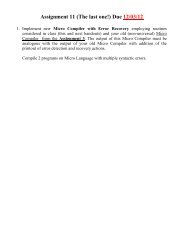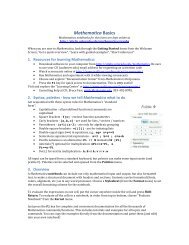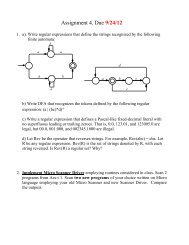[PDF] The Thickness and Chromatic Number of r - Gammeter.com
[PDF] The Thickness and Chromatic Number of r - Gammeter.com
[PDF] The Thickness and Chromatic Number of r - Gammeter.com
You also want an ePaper? Increase the reach of your titles
YUMPU automatically turns print PDFs into web optimized ePapers that Google loves.
<strong>The</strong>orem 11 bounds the thickness <strong>of</strong> Knr by 3( n r + 1) 6 2<br />
Knr has thickness exactly rn<br />
rn 3r<br />
+ 1. Since limr→∞ + 6 4 2<br />
in <strong>The</strong>orem 11 is not especially good.<br />
rn 3r = + . On the other h<strong>and</strong>,<br />
4 2<br />
rn − ( + 1) = ∞, the bound<br />
6<br />
5 <strong>Chromatic</strong> <strong>Number</strong>s <strong>of</strong> r-inflated Graphs<br />
It is straightforward to give an upper bound for the chromatic number <strong>of</strong> G[r] by way<br />
<strong>of</strong> the chromatic number <strong>of</strong> G. This result is given in the next theorem. Further, we<br />
will see that this upper bound can be achieved for every r ∈ Z + by the graph I[r].<br />
<strong>The</strong>orem 12. If χ(G) = k, then χ(G[r]) ≤ rk.<br />
Pro<strong>of</strong>. Suppose that χ(G) = k. Consider the set <strong>of</strong> rk colors {11, . . . , 1r, 21, . . .,<br />
2r, . . ., k1, . . ., kr}. If vertex v in G is colored s in a proper k-coloring <strong>of</strong> G then<br />
color the associated vertices <strong>of</strong> G[r] with s1, . . . , sr. <strong>The</strong>re are two types <strong>of</strong> adjacent<br />
vertices in G[r], those <strong>of</strong> the form vi, vj where both are associated with the vertex<br />
v in G but i �= j, <strong>and</strong> those <strong>of</strong> the form vi, uj where the associated vertices v <strong>and</strong><br />
u are adjacent in G. If the color <strong>of</strong> v in G is s then colors <strong>of</strong> vi <strong>and</strong> vj in G[r] are<br />
si <strong>and</strong> sj. Since i �= j, these are different colors. If u <strong>and</strong> v are adjacent in G <strong>and</strong><br />
are colored s <strong>and</strong> t, then s �= t which implies that si �= tj. Thus we have described a<br />
proper rk-coloring <strong>of</strong> G[r]. We conclude that if χ(G) = k, then χ(G[r]) ≤ rk.<br />
Example 5. <strong>The</strong> icosahedral graph I is 4-chromatic <strong>and</strong> has independence number<br />
three. By Observation 5, I[r] also has independence number three <strong>and</strong> thus its<br />
3 1<br />
independence ratio is = . Since the chromatic number is at least the inverse<br />
12r 4r<br />
<strong>of</strong> independence ratio, the chromatic number <strong>of</strong> the r-inflation is at least 4r. By<br />
<strong>The</strong>orem 12 it is also at most 4r. Thus χ(I[r]) = 4r. Recall that by <strong>The</strong>orem 8 we<br />
also know that the thickness <strong>of</strong> G[r] is precisely r. Thus {I[r]} ∞ r=1 provides a rare<br />
substantive infinite family <strong>of</strong> graphs for which we can determine the precise thickness<br />
<strong>and</strong> the precise chromatic number. (See [BGS08] for another such example). Even<br />
more, this example shows that the largest possible chromatic number for an r-inflated<br />
planar graph is achieved for every positive integer r.<br />
<strong>The</strong>orem 13. If the clique number ω(G) equals the chromatic number χ(G), then<br />
χ(G[r]) = rχ(G).<br />
Pro<strong>of</strong>. Suppose that χ(G) = ω(G). By Observation 6, ω(G[r]) = rω(G). But<br />
ω(G[r]) ≤ χ(G[r]), so rω(G) = ω(G[r]) ≤ χ(G[r]). By our assumption we can<br />
replace ω(G) with χ(G) so rχ(G) ≤ χ(G[r]). However, by <strong>The</strong>orem 12 we know that<br />
χ(G[r]) ≤ rχ(G). Thus we have equality.<br />
19


![[PDF] The Thickness and Chromatic Number of r - Gammeter.com](https://img.yumpu.com/3978766/19/500x640/pdf-the-thickness-and-chromatic-number-of-r-gammetercom.jpg)





